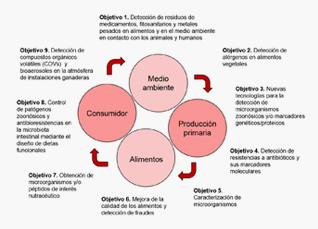Improving food security
Food safety is an important value to achieve and maintain in today's increasingly globalized food industry. The presence of potential zoonotic pathogens in food is a major cause of human illness in both developing and developed countries. Many of these pathogens are of concern to health authorities and is becoming increasingly clear that early detection and surveillance are key to reducing the prevalence and incidence of these diseases. The "one health, one medicine" assumes that the health of persons can not be focused solely on the study of clinical processes experienced by consumers, as estimated concept that 70% of diseases emerging or re-emerging zoonotic against people or vector-borne processes must. Thus, the health concept should also include animal health and the environment.
Infectious agents included in the program are mainly those related to surveillance and control programs and / or those in which food animals or food of animal origin have been identified as the main reservoir (Salmonella, Verotoxigenic Escherichia coli, Campylobacter, Mycobacterium bovis, etc.). The need for rapid detection of potential agents responsible for food poisoning and / or its virulence or resistance markers, requires the incorporation of advanced technologies. Furthermore, to determine a causal relationship between the detection of the pathogen, its transmission routes and identify associated risk factors, it is essential to the characterization of microorganisms. The application of advanced techniques provide the basis for epidemiological studies, which in turn will identify control measures to limit the spread of pathogens. Furthermore, highly scattered microorganisms or under the primary control programs sector defining significant markers from a viewpoint of public health would be beneficial in optimizing the use of resources. On the other hand, advanced technologies also allow differentiating molecular characterization and / or protein markers that could result in pathogenic microorganisms have great potential for use in industry, as lactococci.
In addition to these microorganisms it is to evaluate the presence of antimicrobial resistance determinants. In recent years, the problem of antibiotic resistance has become important in terms of public health throughout the world given the limitations in the treatment of infections. Increasing resistant microorganisms not only restricted to the hospital environment, where a selective pressure is produced by the presence of antimicrobials, but also animals and the environment constitute a reservoir of these organisms and their resistance genes, which can be transmitted to humans through the food chain. The presence of resistance genes in foods has been found in several studies and antimicrobial resistance in animals and food is included in the monitoring programs established by the European Union. The surveillance studies are essential to detect resistant organisms and the use of new technology could be useful for the detection and characterization of these microorganisms and resistance genes in a fast and accurate.
Among the aspects of food security, the program also includes the detection of drug residues, pesticides and heavy metals, which increased level of inclusion in food and water (irrigation, consumption and bathroom), are a huge concern because some of these substances, incorporated in the food chain may have a significant biological activity as the selection of antimicrobial resistance for example.
Finally, in relation to food safety, we have included food allergies, which are of concern to both consumers and the food industry and public administrations. Allergen detection requires highly sensitive techniques, and as an added bonus in the program is intended to operate a tool that is adaptable for the detection of other allergens other than those initially selected.





